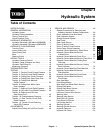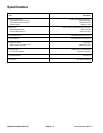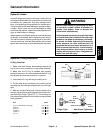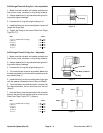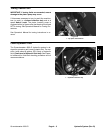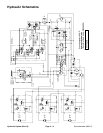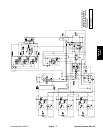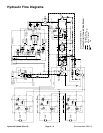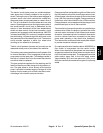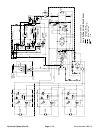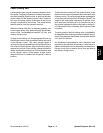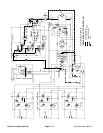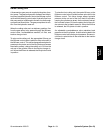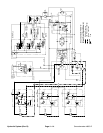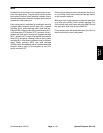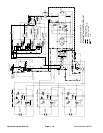
Rev. E
Groundsmaster 4000--D Hydraulic System (Rev. B)Page 4 -- 9
Traction Circuit
The traction circuit piston pump is a variable displace-
ment pump that is directly coupled to the engine fly-
wheel. Pushing the top of the traction pedal engages a
hydraulic servo valve which controls the variable dis-
placement piston pump swash plate to create a flow of
oil. This oil is directed to the front wheel and rear axle
motors. Operating pressureon the high pressure side of
the closed traction circuit loop is determined by the
amount of load developed at the fixed displacement
wheel and axle motors. As the load increases, circuit
pressure can increase to relief valve settings: 4000 PSI
in forward and 5000 PSI in reverse. If pressure exceeds
the relief setting, oil flows through the relief valve to the
low pressure side of the closed loop circuit. The traction
circuit provides operation in either four wheel drive
(mowing) or two wheel drive (transport).
Traction circuit pressure (forward and reverse) can be
measured at test ports on the sides of the machine.
The traction pump uses asmall amountof hydraulic fluid
for internal lubrication. Fluid is designed to leak across
pump parts into the case drain. This leakage results in
the loss of hydraulic fluid from the closed loop traction
circuit that must be replaced.
The gear pump that supplies o il to the steering and lift/
lower circuits also provides charge oil for the traction cir-
cuit. This gear pump is driven directly off the traction
pump. It provides a constant supply of charge oil to the
traction circuit to make up for oil that is lost due to inter-
nal leakage in the traction pump and motors.
Charge pump flow is directed through the oil filter and to
the low pressure side of the closed loop traction circuit.
A filter bypass valve allows charge oil flow to the closed
loop if the filter becomes plugged. Charge pressure is
limited by a relief valve located in the oil filter manifold.
Charge pressure can be measured at the charge circuit
pressure test port on the oil filter manifold.
Two wheel drive (transport) operation is controlled by a
solenoid valve. When in transport, hydraulic flow to the
rear axle motor is blocked in both forward and reverse
directions. A transport cylinder is included in the traction
circuit to reduce control arm movement on the piston
pump when operating in two wheel drive (transport).
This reduced arm movement limits swash plate rotation
to prevent excessive transport speed.
On machines with serial numbers above 230000000, a
flow divider is incorporated into the traction circuit.
When in four wheel drive, the operator can momentarily
engage the traction flow divider when low traction situa-
tions could lead to wheel spin. The engaged flow divider
splits traction pump flow to the front wheel motors
(approximately 45%) and rear axle motor (55%) to re-
duce the chance that excessive flow goes to a spinning
wheel.
Hydraulic
System



